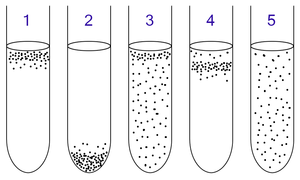geoj
Active Member
Well Joe, here is the basic types of bacteria the link has more in depth info. I can't at this time give you a source but, many bacteria can use multiple sources of carbon, they have a primary and a secondary source. So I can't agree with the idea that bacteria will be harmed only that there growth will slow when there primary food is depleted. There is normally a bacteria that takes over the carbon reduction as its primary source increase as the other bacterias decrease.

Aerobic and anaerobic bacteria can be identified by growing them in liquid culture:
1: Obligate aerobic (oxygen-needing) bacteria gather at the top of the test tube in order to absorb maximal amount of oxygen.
2: Obligate anaerobic bacteria gather at the bottom to avoid oxygen.
3: Facultative bacteria gather mostly at the top, since aerobic respiration is the most beneficial one; but as lack of oxygen does not hurt them, they can be found all along the test tube.
4: Microaerophiles gather at the upper part of the test tube but not at the top. They require oxygen but at a low concentration.
5: Aerotolerant bacteria are not affected at all by oxygen, and they are evenly spread along the test tube.
http://en.wikipedia.org/wiki/Anaerobic_organism

Aerobic and anaerobic bacteria can be identified by growing them in liquid culture:
1: Obligate aerobic (oxygen-needing) bacteria gather at the top of the test tube in order to absorb maximal amount of oxygen.
2: Obligate anaerobic bacteria gather at the bottom to avoid oxygen.
3: Facultative bacteria gather mostly at the top, since aerobic respiration is the most beneficial one; but as lack of oxygen does not hurt them, they can be found all along the test tube.
4: Microaerophiles gather at the upper part of the test tube but not at the top. They require oxygen but at a low concentration.
5: Aerotolerant bacteria are not affected at all by oxygen, and they are evenly spread along the test tube.
http://en.wikipedia.org/wiki/Anaerobic_organism
